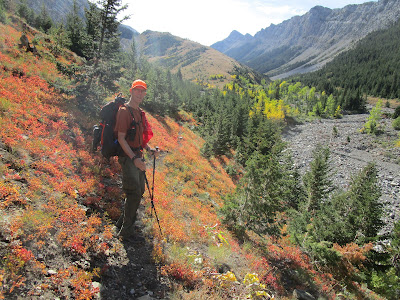 |
| Colorado Mountain (right) on a ridgeline |
 | ||
Our route
|
 |
| The top cairn with Black Mountain below |
 |
| Katie with ground cover and copious deadfall along the trail |
This followed a four day trip to Salt Lake City with sidetrips to Teton and Yellowstone national parks on the way home. The red aspen and dramatic landscapes are a must see in the Fall.
My wife and I got part way up on a Montana Wilderness Association snowshoe walk two years ago.
This time, despite tons of windfalls on the upper part of the trail, we got to the top, a 8.5 miles, 2,400 feet elevation gain and loss on a gorgeous Fall day.
The trail is largely unmarked, which I found remarkable given that there was once a major lookout cabin there, now long gone. Unless you knew there was a trail there you couldn't find it. The trail is not marked on the Forest Service map.
 |
| A break at top |
It immediately gains a ridge west, above Moose Creek, climbing 2 miles to another flat spot to the south, where the Colorado Mountain summit ridge begins. It travels up another 2.25 miles and 1,000 feet from here through deadfalls splayed like pickup sticks across the trail, which had to be dodged.
The grassy, exposed and windy top offers a great 360 view of the Helena area; the Big Belts, Gates of the Mountains, Elkhorns, Continental Divide country into the Scapegoat and Bob Marshall and even the Bridger Mountains. We could see Chessman Reservoir below. Almost on top of us were Red Mountain another almost 1,000 feet above us at 8,160 feet, and the Rimini ghost town, and Black Mountain at 7,148 below us as a twin peak.
We were sad to see the lookout was gone, with only remnants of the structure's footings remaining at the high point.
There is a rock pathway to a rock outcrop in the trees to the southeast that offered shelter from the wind.
My takeaways from the hike: it's terrific to have a national forest roadless area so close to a major city; it's too bad that there's so much diseased and down timber there, the trail could be better marked.























